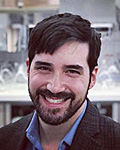Bridging the Gap Between Large and Small: Thermofluids and Nanoengineering for the Water-Energy Nexus
Category
Published on
Abstract
Climate change, degrading water resources, and economic and population growth are increasing the need for new science and technologies at the Water-Energy-Food Nexus. In enabling new and improved technologies to tackle these issues, a thermofluids systems approach is essential to guide the design of new nanomaterials, allowing for performance improvements and new capabilities. Following this approach, thermodynamic design of water treatment membrane technologices such as membrane distillation (MD) leads to innovations with superhydrophobic nanostructured surfaces for heat transfer. New structures can also be created and optimized with this approach to operate in large systems. Nanomaterial self-assembly techniques can be guided by thermofluids designs to make macro-scale membrane systems with photonic properties for catalysis and solar distillation.
Bio
 Dr. David Warsinger completed his B.S. and M.Eng at Cornell, and his PhD in Mechanical Engineering at MIT: he completed his graduate studies in a combined 3 years. David’s research focuses on the water-energy nexus, with approaches from thermofluids and nanoengineering. Currently, David is a Postdoc at MIT and beginning a joint Postdoc at Harvard. Prior to starting his PhD, David worked at the engineering consulting firm Arup, where he performed energy and sustainability analysis and designed heating and cooling systems. David is a coauthor of 22 published and 6 submitted journal and conference papers, and a co-inventor of 13 filed or awarded patents. He is also involved with entrepreneurial endeavors, including demonstrating batch reverse osmosis with MIT startup Sandymount, and cofounding Coolify, a startup providing refrigeration via phase-change thermal storage for farmers in developing economies. Notable awards David has earned include the national dissertation award from UCOWR, the highest GPA award for his Masters, 9 presenter awards, and the MIT institute award for best research mentor for undergraduate students.
Dr. David Warsinger completed his B.S. and M.Eng at Cornell, and his PhD in Mechanical Engineering at MIT: he completed his graduate studies in a combined 3 years. David’s research focuses on the water-energy nexus, with approaches from thermofluids and nanoengineering. Currently, David is a Postdoc at MIT and beginning a joint Postdoc at Harvard. Prior to starting his PhD, David worked at the engineering consulting firm Arup, where he performed energy and sustainability analysis and designed heating and cooling systems. David is a coauthor of 22 published and 6 submitted journal and conference papers, and a co-inventor of 13 filed or awarded patents. He is also involved with entrepreneurial endeavors, including demonstrating batch reverse osmosis with MIT startup Sandymount, and cofounding Coolify, a startup providing refrigeration via phase-change thermal storage for farmers in developing economies. Notable awards David has earned include the national dissertation award from UCOWR, the highest GPA award for his Masters, 9 presenter awards, and the MIT institute award for best research mentor for undergraduate students.
Sponsored by
References
- D. Warsinger, J. Swaminathan, L. Morales, and J. Lienhard V, “Comprehensive Condensation Flow Regimes in Air Gap Membrane Distillation: Visualization and Energy Efficiency”, Journal of Membrane Science, vol. 555, pp. 517-528, June 2018, https://doi.org/10.1016/j.memsci.2018.03.053
- D. Warsinger, J. Swaminathan, L. Maswadeh, and J. Lienhard V, “Superhydrophobic condenser surfaces for air gap membrane distillation,” Journal of Membrane Science, vol. 492, pp. 578 – 587, 2015, https://doi.org/10.1016/j.memsci.2015.05.067.
- D. Warsinger, J. Swaminathan, and J. Lienhard V, “Effect of module inclination angle on air gap membrane distillation,” Proceedings of the 15th International Heat Transfer Conference (IHTC-15), Aug. 2014, http://hdl.handle.net/1721.1/100241.
- N. Miljkovic, R. Enright, Y. Nam, K. Lopez, N. Dou, J. Sack, and E. N. Wang, “Jumping-droplet-enhanced condensation on scalable superhydrophobic nanostructured surfaces,” Nano Letters, vol. 13, no. 1, pp. 179–187, 2013. PMID: 23190055, https://doi.org/10.1021/nl303835d.
- J. Swaminathan, D. Warsinger, J. Lienhard V, “Hydrophobic air-gap membrane distillation,” US9751047B2, MIT, September 9, 2015.
- Global water intelligence and water desalination report,” G. W. Intelligence, Nov. 2014, http://desaldata.com
- “The principle of desalination,” Aquanext, http://www.aquanext-inc.com/en/product/desalination02.html
- D. Warsinger, E. Tow, K. Nayar, L. Maswadeh, and J. Lienhard V, “Energy efficiency of batch and semi-batch (ccro) reverse osmosis desalination,” Water Research, vol. 106, pp. 272 – 282, 2016, https://doi.org/10.1016/j.watres.2016.09.029.
- D. Warsinger, R. McGovern, G, Thiel, E. Tow, and J. Lienhard V, “Batch pressure-driven membrane separation with closed-flow loop and reservoir,” US20170239620A1, MIT, February 22, 2016.
- D. Warsinger, E. Tow, L. Maswadeh, G. Connors, J. Swaminathan, and J. Lienhard V, “Inorganic fouling mitigation by salinity cycling in batch reverse osmosis,” Water Research, vol. 137, pp. 384 – 394, 2018, https://doi.org/10.1016/j.watres.2018.01.060.
- D. Warsinger, J. Swaminathan, R. Stover, E. Tow, and J. Lienhard V, “Effect of practical losses on optimal design of batch ro systems,” The International Desalination Association World Congress, Oct. 2017. Sao Pauelo, Brazil, International Desalination Association.
- Group of Nanomagnetism and Magnetization Processes, “Oxide nanoporous membranes.” Instituto de Ciencia de Materiales de Madrid, CSIC, https://wp.icmm.csic.es/gnmp/techniques/oxide-nanoporous-membranes/
- H. Risken and T. Caugheyz, “The fokker-planck equation, methods of solution and applications,” Journal of the Optical Society of America B Optical Physics, vol. 58, p. 860, 1991.
- S. Duhr and D. Braun, “Why molecules move along a temperature gradient,” Proceedings of the National Academy of Sciences, vol. 103, no. 52, pp. 19678–19682, 2006, https://doi.org/10.1073/pnas.0603873103.
- A. Servi, E. Guillen-Burrieza, D. Warsinger, W. Livernois, and K. Notarangelo, “The Effects of iCVD Film Thickness and Conformality on the Permeability and Wetting of MD Membranes”, Journal of Membrane Science, vol. 523, pp. 470-479, Feb. 2017, https://doi.org/10.1016/j.memsci.2016.10.008.
- J. Lienhard V, G. Thiel, D. Warsinger, and L. Banchick, “Low Carbon Desalination: Status and Research, Development, and Demonstration Needs”, Massachusetts Institute of Technology, Oct. 2016, http://hdl.handle.net/1721.1/105755.
Cite this work
Researchers should cite this work as follows:
Time
Location
Room 1001, Birck Nanotechnology Center, Purdue University, West Lafayette, IN